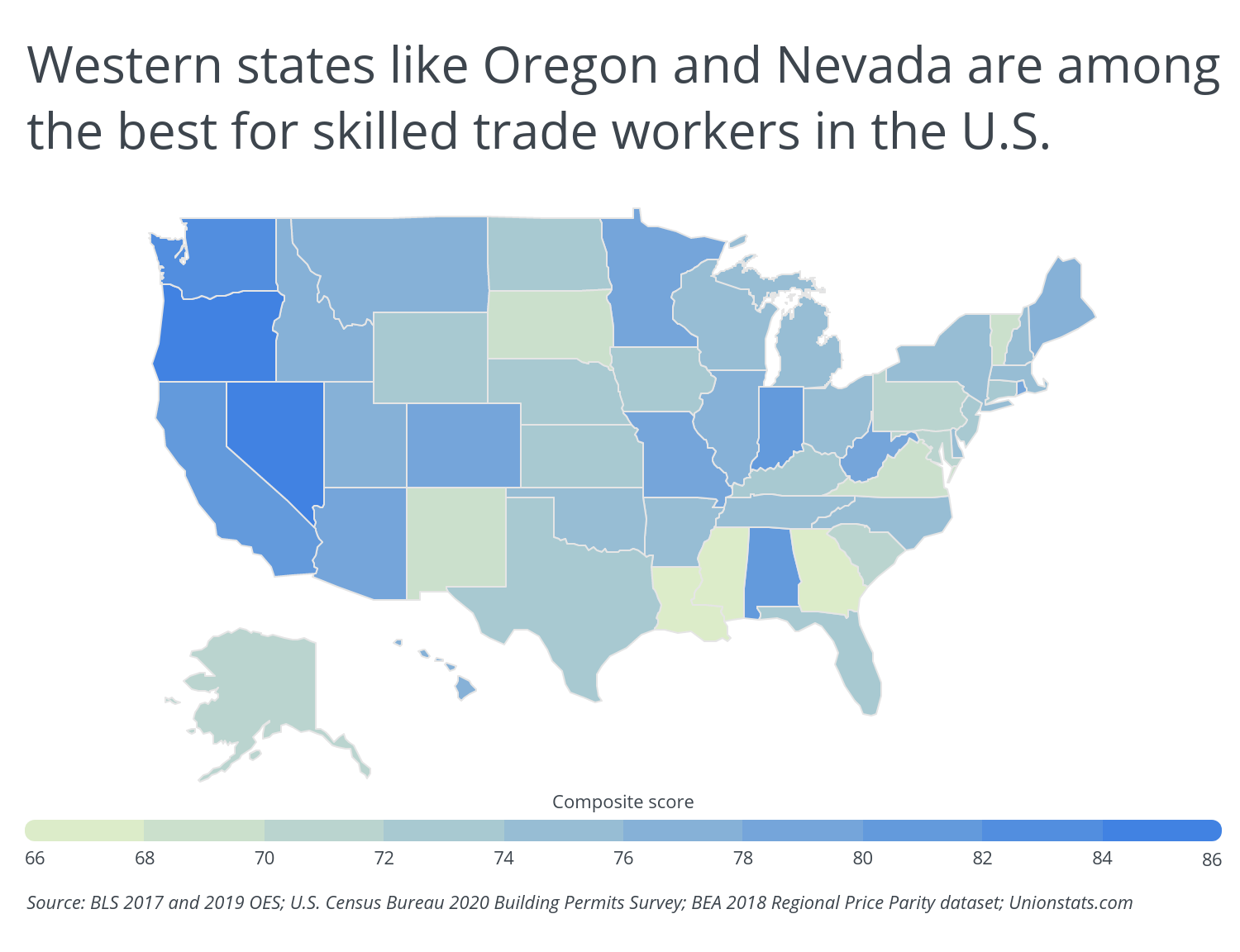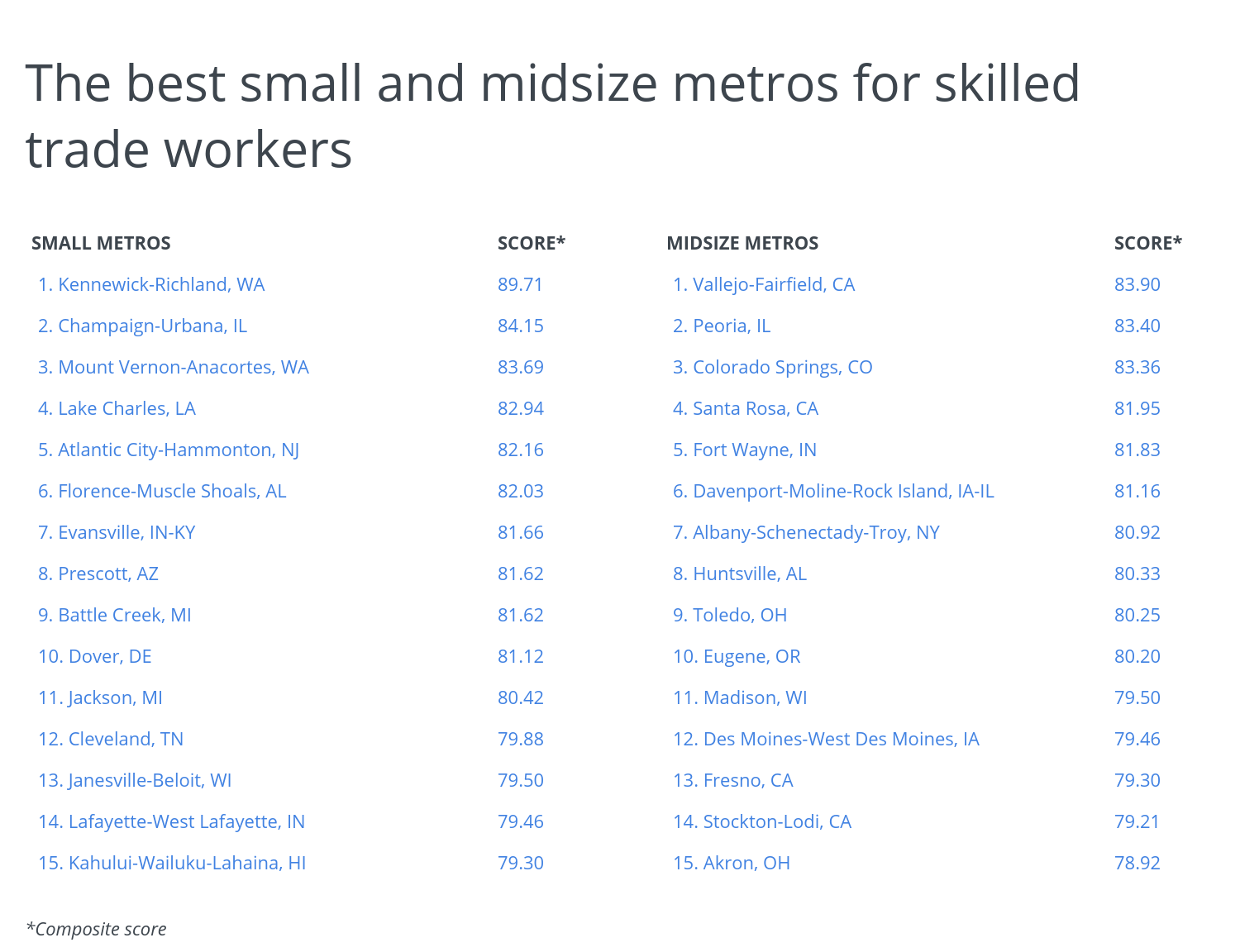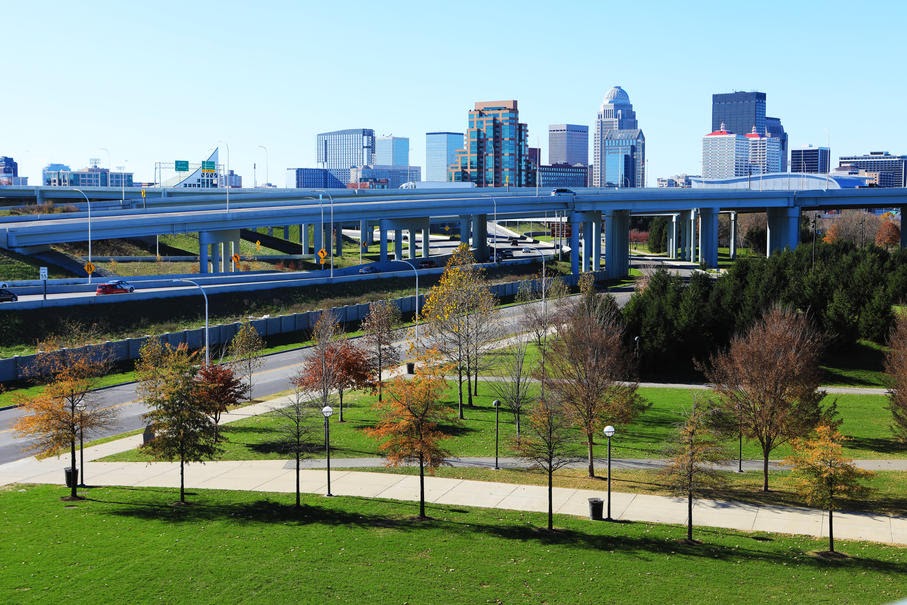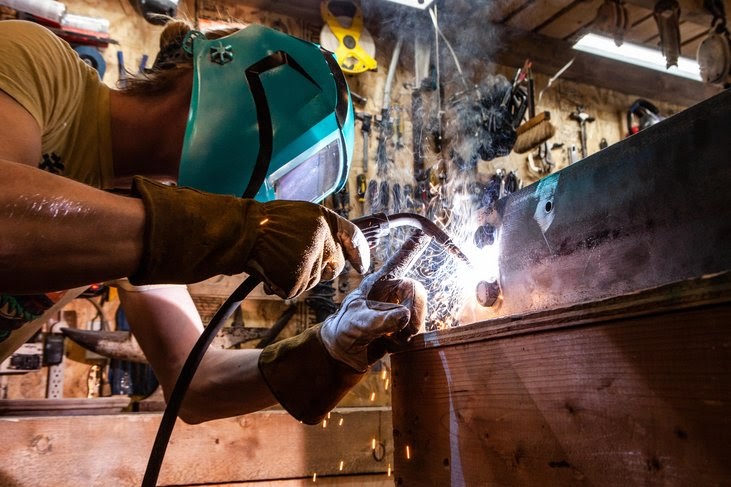The U.S. is facing a shortage of skilled trade laborers. This is due to several factors, including the culture’s emphasis on getting a four-year college degree and an increasing number of retiring Baby Boomers. The shortage of skilled trade labor has pushed up wages in these occupations. According to data from the Bureau of Labor Statistics, the median annual earnings for skilled wage occupations is $47,428, nearly 20% higher than that across all workers.
While there is a shortage of skilled trade workers nationally, the concentration of skilled trade workers varies significantly on a geographic basis. Some parts of the country have older workforces and more skilled trade veterans that are retiring. Vocational programs are also more popular in some areas than others. At the state level, Wyoming and Louisiana have the highest percentage of skilled trade workers in the U.S. Skilled trade employment makes up 8.5% and 6.6% of total employment in Wyoming and Louisiana, respectively.

To find the best areas in the U.S. for skilled trade workers, researchers at Porch analyzed data from the Bureau of Labor Statistics, the U.S. Census Bureau, the Bureau of Economic Analysis, and Unionstats.com and created a composite score based on the following factors:
- Median annual wage for skilled trade workers: the median annual wage for workers in skilled trade occupations
- New residential construction spending per skilled trade worker: value of new residential construction per skilled trade worker
- Employment growth for skilled trade workers: growth in the employment of skilled trade workers over the past two years
- Private union membership: percentage of private industry workers with union membership
- Cost of living: cost of living relative to the national average
At the state level, the best states for skilled trade workers are in the West. According to the composite score, the highest ranking state is Nevada, where median annual earnings for skilled trade workers is nearly $50,000. Both Oregon and Washington also rank highly among states and offer attractive wages for tradesmen. All of these states also show higher-than-average employment growth in skilled trades and have high rates of private union membership. At the national level, skilled trade employment grew by 6% from 2017 to 2019, and 6.2% of private industry workers belong to unions.
TRENDING
Porch has guides and detailed cost estimates for countless home improvement projects. Find out what a baseboard installation would cost you, what an hvac unit replacement cost would be in your area, and much more with Porch.

Researchers at Porch ranked metro areas according to their composite score. To improve relevance, only metropolitan areas with at least 100,000 people were included in the analysis. Additionally, metro areas were grouped into the following cohorts based on population size:
- Small metros: 100,000–349,999
- Midsize metros: 350,000–999,999
- Large metros: 1,000,000 or more
Here are the best metros for skilled trade workers.

Best Large Metros for Skilled Trade Workers

Photo Credit: Alamy Stock Photo
15. Pittsburgh, PA
- Composite score: 77.59
- Median annual wage for skilled trade workers: $52,473
- New residential construction spending per skilled trade worker: $7,200
- Employment growth for skilled trade workers: 4.9%
- Private union membership: 9.2%
- Cost of living: 6.9% below average
RELATED
How much does it cost to replace a bathtub? Our cost calculator will give you a range of average prices in your area.

Photo Credit: Alamy Stock Photo
14. Boston-Cambridge-Newton, MA-NH
- Composite score: 79.05
- Median annual wage for skilled trade workers: $60,558
- New residential construction spending per skilled trade worker: $32,462
- Employment growth for skilled trade workers: 11.0%
- Private union membership: 5.7%
- Cost of living: 14.2% above average

Photo Credit: Alamy Stock Photo
13. Minneapolis-St. Paul-Bloomington, MN-WI
- Composite score: 79.17
- Median annual wage for skilled trade workers: $60,280
- New residential construction spending per skilled trade worker: $46,251
- Employment growth for skilled trade workers: 4.3%
- Private union membership: 7.9%
- Cost of living: 2.6% above average

Photo Credit: Alamy Stock Photo
12. Indianapolis-Carmel-Anderson, IN
- Composite score: 79.67
- Median annual wage for skilled trade workers: $48,178
- New residential construction spending per skilled trade worker: $44,913
- Employment growth for skilled trade workers: 6.4%
- Private union membership: 5.4%
- Cost of living: 8.4% below average

Photo Credit: Alamy Stock Photo
11. Seattle-Tacoma-Bellevue, WA
- Composite score: 80.00
- Median annual wage for skilled trade workers: $61,771
- New residential construction spending per skilled trade worker: $41,874
- Employment growth for skilled trade workers: 4.2%
- Private union membership: 12.7%
- Cost of living: 12.9% above average

Photo Credit: Alamy Stock Photo
10. Cincinnati, OH-KY-IN
- Composite score: 80.25
- Median annual wage for skilled trade workers: $48,106
- New residential construction spending per skilled trade worker: $25,619
- Employment growth for skilled trade workers: 8.3%
- Private union membership: 6.7%
- Cost of living: 10.0% below average

Photo Credit: Alamy Stock Photo
9. Louisville/Jefferson County, KY-IN
- Composite score: 80.45
- Median annual wage for skilled trade workers: $47,735
- New residential construction spending per skilled trade worker: $25,221
- Employment growth for skilled trade workers: 8.1%
- Private union membership: 8.1%
- Cost of living: 9.8% below average

Photo Credit: Alamy Stock Photo
8. San Francisco-Oakland-Hayward, CA
- Composite score: 81.12
- Median annual wage for skilled trade workers: $69,513
- New residential construction spending per skilled trade worker: $28,447
- Employment growth for skilled trade workers: 12.7%
- Private union membership: 9.7%
- Cost of living: 31.6% above average

Photo Credit: Alamy Stock Photo
7. Kansas City, MO-KS
- Composite score: 81.75
- Median annual wage for skilled trade workers: $50,693
- New residential construction spending per skilled trade worker: $40,603
- Employment growth for skilled trade workers: 7.1%
- Private union membership: 7.1%
- Cost of living: 7.1% below average

Photo Credit: Alamy Stock Photo
6. Riverside-San Bernardino-Ontario, CA
- Composite score: 81.83
- Median annual wage for skilled trade workers: $50,079
- New residential construction spending per skilled trade worker: $37,055
- Employment growth for skilled trade workers: 12.5%
- Private union membership: 14.8%
- Cost of living: 7.0% above average

Photo Credit: Alamy Stock Photo
5. Birmingham-Hoover, AL
- Composite score: 81.86
- Median annual wage for skilled trade workers: $43,218
- New residential construction spending per skilled trade worker: $35,046
- Employment growth for skilled trade workers: 9.9%
- Private union membership: 8.2%
- Cost of living: 11.3% below average
TRENDING
New vinyl siding can do wonders for the look of your house. For information on the cost of vinyl siding installation, reference our location-specific guide.

Photo Credit: Alamy Stock Photo
4. Portland-Vancouver-Hillsboro, OR-WA
- Composite score: 82.03
- Median annual wage for skilled trade workers: $57,582
- New residential construction spending per skilled trade worker: $40,315
- Employment growth for skilled trade workers: 12.8%
- Private union membership: 7.6%
- Cost of living: 3.8% above average

Photo Credit: Alamy Stock Photo
3. St. Louis, MO-IL
- Composite score: 82.74
- Median annual wage for skilled trade workers: $58,038
- New residential construction spending per skilled trade worker: $25,077
- Employment growth for skilled trade workers: 3.2%
- Private union membership: 10.7%
- Cost of living: 9.0% below average

Photo Credit: Alamy Stock Photo
2. Sacramento–Roseville–Arden-Arcade, CA
- Composite score: 82.78
- Median annual wage for skilled trade workers: $52,873
- New residential construction spending per skilled trade worker: $52,189
- Employment growth for skilled trade workers: 13.4%
- Private union membership: 8.2%
- Cost of living: 3.6% above average

Photo Credit: Alamy Stock Photo
1. Las Vegas-Henderson-Paradise, NV
- Composite score: 83.61
- Median annual wage for skilled trade workers: $49,504
- New residential construction spending per skilled trade worker: $47,374
- Employment growth for skilled trade workers: 10.6%
- Private union membership: 13.1%
- Cost of living: 3.2% below average
Detailed Findings & Methodology
The Las Vegas metro area is the best large metro in the country for skilled trade workers with a composite score of almost 84. While the cost of living in Las Vegas is lower than average, the median annual wage for skilled trade workers is higher than the national median of $47,428. The area has a high level of private union membership as well as a high level of construction spending. Other large metros that are best for skilled trade workers rank well in all or most of the composite score factors.
The small and midsize metros that are best for skilled trade workers are spread out across the country, but many are located in the West and Midwest. These metros tend to have high median wages for skilled trade workers—or at least a low cost of living—and also rank highly with the other metrics. On average, spending on new residential construction is $37,164 per skilled trade worker in the U.S. Some metros—including Colorado Springs, CO, Prescott, AZ, and Dover, DE—boast new residential construction spending per skilled trade worker at levels several times higher than this.
To find the best areas in the U.S. for skilled trade workers, researchers at Porch analyzed data from the Bureau of Labor Statistics’s 2017 and 2019 Occupational Employment Survey (OES), the U.S. Census Bureau’s 2020 Building Permits Survey (BPS), the Bureau of Economic Analysis’s 2018 Regional Price Parities (RPP), and union membership data from Unionstats.com. The researchers created a composite score based on the following factors (weighted equally):
- Median annual wage for skilled trade workers: the median annual wage for workers in skilled trade occupations in 2019
- New residential construction spending per skilled trade worker: the total value of building permits issued for new residential construction (per skilled trade worker) in 2020
- Employment growth for skilled trade workers: percentage change in the total employment of skilled trade workers from 2017 to 2019
- Private union membership: percentage of private industry workers with union membership
- Cost of living: cost of living relative to the national average
Metro areas were ranked according to their composite score. Additionally, metros were grouped into the following cohorts based on population size:
- Small metros: 100,000–349,999
- Midsize metros: 350,000–999,999
- Large metros: 1,000,000 or more



